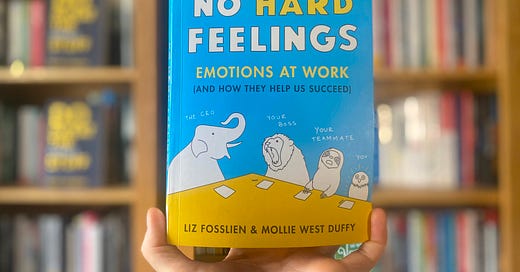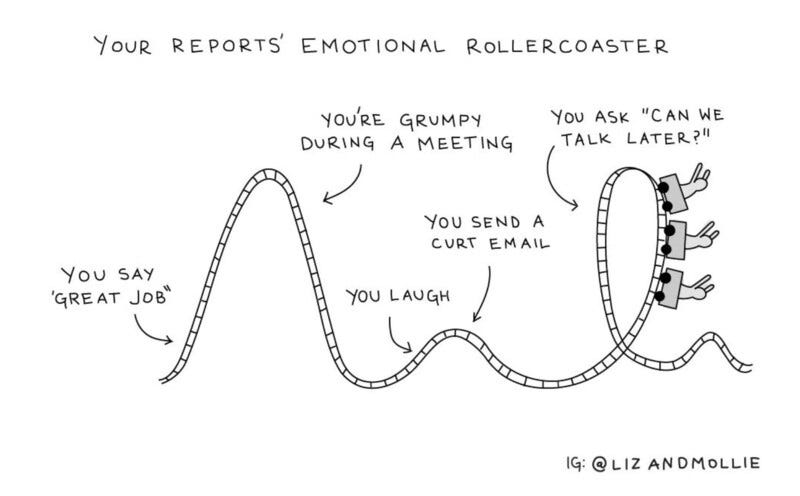Emotions at work can be a sticky topic. Whilst most of us realise that the idea of “leaving emotion at the door” is, in reality, not an option, there’s still a pervasive belief that emotions at work are bad, unhelpful and frankly best avoided. No Hard Feelings debunks that in an informative and sometimes laugh-out-loud funny way. It points the way to creating workplaces that allow our humanity and emotional expression, yet remain respectful, productive, and ultimately enjoyable places to be. Best of all (at least for me) this feels like the opposite of a business book. It’s packed with charming illustrations to emphasise the points made, helping make it as accessible and engaging as it is practical.
What’s it all about then?
Human beings are emotional beings. Emotions and emotional dynamics affect our relationships, motivation, health, self-esteem, communication, decision-making and so much more. Yet the idea that to be professional is also to be unemotional is frustratingly pervasive. No Hard Feelings tackles that idea head on and thoroughly debunks it.
Instead of seeing emotions as a problem, Fosslien and West Duffy make the case that emotions provide us with data and insight, and can be harnessed to our benefit. The goal they lay out is to go beyond being emotionally intelligent – being able to recognise and understand how you and those around you feel. Instead, the skill to develop is emotional fluency:
“…the capacity to productively sense emotion, and to know how and when to translate what you feel into healthy action.”
This led to the creation of their new rules of emotion at work, which form the seven main chapters of the book.
Looking at each, in brief:
Health: be less passionate about your job
Caring is great. Caring too much is unhelpful and unhealthy. Learning to stop overestimating our own importance and take real, genuine breaks is key. It’s also healthy to make time to be “rigorously unproductive” – to let go of the idea that we should always be doing something or producing something. It’s OK to let go.
Motivation: inspire yourself
This addresses our twin tendencies to (a) rely on motivation that is external to us and (b) see motivation as a once-and-done thing that should last forever. The chapter explores the idea that motivation is something we can create for ourselves, and that it is a dynamic, ongoing process. We often underestimate our own agency to make changes and shift to do more work we enjoy. And, if we invest in relationships and push ourselves to learn, they also provide a path to fresh motivation.
Decision making: emotion is part of the equation
Recognising that emotions are a valuable part of decision-making allows us to think about “which emotions might be informative, and then regulate the rest.” If you’re denying your feelings, the risk is that they’re controlling you anyway. By engaging with them, they provide valuable inputs and we can be more rational about those we recognise as unhelpful. Anticipation, anxiety, regret, anger and stress are all trying to tell us something, if we’re willing to listen. Though, it’s equally important to understand that listening to our emotions is not, and does not have to be the same as acting on them.
Teams: the how matters more than the what
This chapter provides an introduction to psychological safety, what it is and how to start to create it. It draws out the important distinction between task conflict – often productive and performance-enhancing – and relationship conflict, which can risk getting personal. For the latter, it’s OK to disagree or even dislike someone, and we don’t have to get personal. Recognising our differences and being willing to hear people out can go a long way. Finally, Fosslien and West Duffy look at jerks, dissenters and slackers at work, and how to deal with them.
Communication: your feelings aren’t facts
This looks at difficult – read also emotional – conversations at work and how to approach them. It includes suggestions for addressing feelings calmly, and crucially without making assumptions about intent, even when the impact was poor. It touches on our inherent biases and habits, and how they can affect what we say and hear, and how to give feedback well. It also briefly addresses the challenge of online communication, the potential for misunderstanding and how to “emotionally proofread” what we send.
Culture: emotional culture cascades from you
A topic close to my own heart, this looks at emotional contagion and how our emotions and emotional norms affect those around us. No Hard Feelings talks about micro-actions – small gestures that act as social signals. By making these positive and intentional we can create a healthy emotional culture in our teams. It also touches on emotional labour, both seen and unseen, and how to create belonging, especially in remote or hybrid teams.
Leadership: be selectively vulnerable
Vulnerability is generally acknowledged as a good thing for leaders; our brains respond positively when we feel an emotional connection to a boss, leading us to try harder, perform better and be kinder. And there’s a balance to be struck. Oversharing can destroy trust, diminish respect and cause people to doubt your ability to do the job. Being selectively vulnerable is to be thoughtful about what and when you share, and to show a path forward. The book cautions against seeking to manage other people’s emotions, or tell others how to feel, but instead to listen and validate. Finally it acknowledges the importance of understanding, managing, and taking care of yourself.
No Hard Feelings concludes with chapter summaries, further resources, and an emotional tendencies assessment to help you understand yourself better.
What are the highlights?
It’s an incredibly accessible book, covering a vast topic in an easy to digest way. There are practical tips and suggestions throughout, so it goes beyond being any kind of academic exercise into something to apply and use.
I’m a huge fan of Fosslien and West Duffy’s illustrations. They have an uncanny knack of capturing ideas and concepts in a way that challenges, educates and also leaves you with a smile on your face. That this book is full of illustrations also adds to the ease and enjoyability of the read.
Anything you didn’t like?
The book’s breadth also risks being its downside, as it skips through some hefty and important topics in just a few paragraphs without giving any real depth of insight. In some ways this book is most useful as a jumping off point, not an end in itself.
The style also comes across as overly simplistic. In trying to make it accessible I felt at times as though it was pointing out the blindingly obvious and being a little patronising. However, I’ve been around long enough to know that while these things might seem obvious to me, they almost certainly aren’t for everyone! So, if you’re already pretty emotionally literate this might not be for you, but if this isn’t a topic you’ve engaged with much this might be perfect.
Why should I read it?
If you’d like a fun and easy to read reminder of some crucial aspects of managing and understanding emotion at work, this is a great read.
Equally, if you’re still of the opinion that emotions don’t belong in a professional environment, I encourage you to read No Hard Feelings to discover that that’s not just an unrealistic view, but actively unhelpful.
No Hard Feelings: Emotions at work (and how they help us succeed)
by Liz Fosslien and Mollie West Duffy. Published by Portfolio Penguin in 2019.
Available at Amazon UK, Amazon US, or Bookshop.org. (#aff links)
Have you read No Hard Feelings? I’d love to hear what you thought, so click here to add a comment or your own review:
And finally…
So many good options for meme of the week this week, but seeing as we’re talking about emotions, this one seemed apt!

If you know someone else who might enjoy this, click here to send it to them directly:
Thank you, and see you next week!






